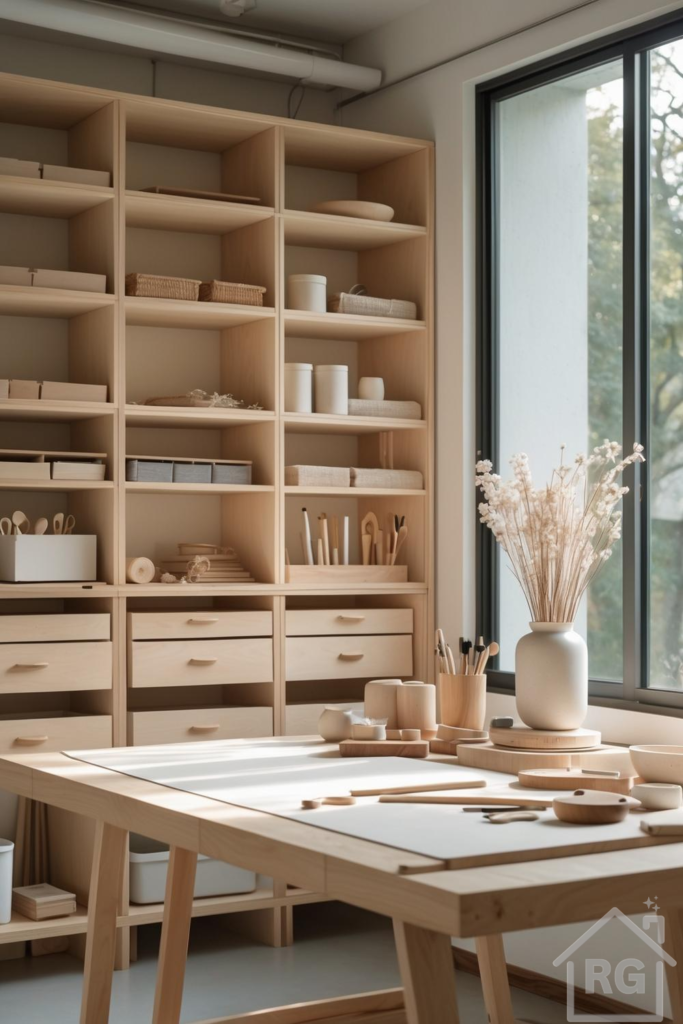
The desire for a dedicated space to create, think, and unwind is universal. Whether you’re an artist, writer, crafter, or simply someone seeking a peaceful corner for hobbies, the environment significantly impacts focus and inspiration.
The image showcases a stunning example of a craft room designed with Japandi principles – a harmonious blend of Japanese minimalism and Scandinavian functionality. This style emphasizes natural materials, muted colors, clean lines, and a deep appreciation for craftsmanship and tranquility. Let’s explore how to recreate this serene and highly functional aesthetic in your own creative space.
Understanding Japandi Design Principles
Before diving into specifics, understanding the core tenets of Japandi design is crucial:
- Minimalism (Kanso): Rooted in Japanese aesthetics, this means simplicity, eliminating clutter, and focusing on essential elements. Every item should have a purpose or bring joy.
- Natural Materials (Shizen): Both Japanese and Scandi design revere nature. Think light woods (birch, maple, oak), bamboo, rattan, stone, ceramic, linen, and cotton. These materials add warmth, texture, and a connection to the outdoors.
- Functionality & Comfort (Hygge): A Scandinavian contribution, emphasizing coziness, well-being, and practical design that enhances daily life. Furniture is comfortable, storage is efficient, and the space feels inviting.
- Craftsmanship & Quality: Both traditions value well-made items built to last, appreciating the beauty in imperfection (Wabi-Sabi).
- Neutral & Muted Color Palette: Colors are drawn from nature – whites, creams, beiges, grays, soft browns, and occasional muted greens or blues. Black is often used as an accent for contrast and definition, as seen in the window frame.
Creating Your Japandi Craft Space: A Step-by-Step Guide
1. Declutter and Organize (The Foundation)
The first step towards a Japandi haven is rigorous decluttering. A creative space can easily become chaotic.
- Assess Everything: Go through all your supplies. Be honest about what you truly use and need.
- Categorize: Group similar items together (paints, papers, tools, fabrics, etc.).
- Purge: Donate, sell, or discard items that no longer serve you.
- Strategic Storage: This is paramount. The goal is ‘a place for everything, and everything in its place,’ but kept visually calm. Utilize:
- Open Shelving: As seen in the image, light wood open shelving allows for easy access but requires curated display. Use uniform containers, baskets, and boxes to maintain order.
- Closed Storage (Drawers): Ideal for hiding less aesthetically pleasing items or smaller bits and pieces. The drawers in the image blend seamlessly with the shelving unit.
- Natural Baskets & Boxes: Woven baskets (like wicker or seagrass) and simple wooden or light gray cardboard boxes add texture while concealing clutter.
- Uniform Containers: Choose simple ceramic or wooden containers for tools like brushes, pencils, and rulers. Avoid loud branding or colors.
2. Choosing the Right Color Palette
Stick to a calming, neutral base.
- Walls: Opt for soft whites (like Benjamin Moore’s Simply White or Chantilly Lace), warm off-whites, or very light, warm grays. This maximizes light reflection.
- Furniture: Light-toned woods (birch, maple, ash, light oak) are key. They provide warmth without overwhelming the space.
- Accents: Introduce subtle contrast with black (window frames, thin metal legs, minimal hardware), deeper wood tones in small doses, or muted, earthy ceramics. Keep the overall feeling light and airy.
3. Selecting Furniture with Form and Function
Japandi furniture is characterized by clean lines, natural materials, and functionality.
- Work Surface: A large, sturdy table is essential. Choose one made from light wood with simple legs, like the trestle-style table shown. Ensure it’s large enough for your projects.
- Shelving: Floor-to-ceiling shelving, as depicted, maximizes vertical space. Look for modular systems or built-ins made from light wood. Ensure the design is simple and unadorned.
- Seating (Not Pictured, but Important): Choose a comfortable chair that supports good posture but maintains the minimalist aesthetic. A simple wooden chair with a cushion or a lightly upholstered ergonomic chair in a neutral fabric would work well.
4. Incorporating Natural Materials and Textures
Texture prevents a neutral space from feeling flat or sterile.
- Wood: The dominant material. Use it for shelving, tables, storage boxes, and even tool handles.
- Ceramics: Matte, unglazed, or subtly glazed ceramics in neutral tones are perfect for vases, pots, and containers. They add an earthy, handcrafted feel.
- Textiles: If using cushions or throws, choose natural fibers like linen, cotton, or wool in solid, muted colors or simple patterns.
- Plants & Dried Botanicals: Bring nature indoors. A simple vase with dried grasses or branches (like in the image) adds texture and organic shape without requiring maintenance. Small, easy-care plants like snake plants or ZZ plants in simple pots also fit well.
- Paper & Craft Materials: Even your supplies contribute to the texture. Stacks of paper, wooden tools, and natural fiber yarns add visual interest when stored neatly.
5. Maximizing Natural Light
Light is crucial for both creativity and the Japandi aesthetic.
- Window Treatments: Keep them minimal. Sheer linen curtains, simple roller blinds in a light neutral color, or even bare windows (if privacy allows) are ideal. Avoid heavy drapes.
- Mirrors: Strategically placed mirrors can help bounce light around the room, making it feel larger and brighter.
- Artificial Lighting: Supplement natural light with layered artificial lighting. Include functional task lighting (a simple desk lamp with clean lines) and ambient overhead lighting (a minimalist pendant or flush mount). Choose warm white bulbs (around 2700K-3000K) to enhance the cozy feel.
6. The Finishing Touches: Simplicity and Intention
Resist the urge to over-decorate.
- Curated Display: Only display items that are beautiful, functional, or hold special meaning. Arrange them thoughtfully on shelves.
- Artwork: If adding art, choose pieces with simple compositions, abstract forms, or nature-inspired themes in muted colors. A single, well-chosen piece is often more impactful than many.
- Embrace Imperfection (Wabi-Sabi): Don’t strive for absolute perfection. The subtle variations in wood grain, the handcrafted nature of a ceramic pot – these imperfections add character and soul to the space.
Maintaining Your Zen Creative Space
A Japandi craft room isn’t just about the initial setup; it’s about maintaining the calm.
- Regular Tidying: Dedicate 5-10 minutes at the end of each creative session to put things away.
- Mindful Purchasing: Before buying new supplies or decor, ask if they truly fit the aesthetic and function of the space.
- Seasonal Refresh: Occasionally reassess your storage and decor to ensure it still serves your needs and brings you joy.
Creating a Japandi-inspired craft room is an investment in your creativity and well-being. By focusing on natural materials, functional design, mindful organization, and a serene color palette, you can build a sanctuary that not only looks beautiful but also fosters focus, inspiration, and a profound sense of peace. Start small, embrace the process, and enjoy crafting in your tranquil new haven.
